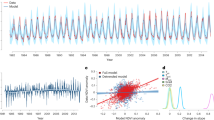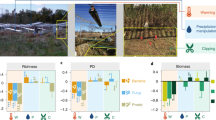Abstract
Temperature governs most biotic processes, yet we know little about how warming affects whole ecosystems. Here we examined the responses of 128 components of a subarctic grassland to either 5–8 or >50 years of soil warming. Warming of >50 years drove the ecosystem to a new steady state possessing a distinct biotic composition and reduced species richness, biomass and soil organic matter. However, the warmed state was preceded by an overreaction to warming, which was related to organism physiology and was evident after 5–8 years. Ignoring this overreaction yielded errors of >100% for 83 variables when predicting their responses to a realistic warming scenario of 1 °C over 50 years, although some, including soil carbon content, remained stable after 5–8 years. This study challenges long-term ecosystem predictions made from short-term observations, and provides a framework for characterization of ecosystem responses to sustained climate change.
This is a preview of subscription content, access via your institution
Access options
Access Nature and 54 other Nature Portfolio journals
Get Nature+, our best-value online-access subscription
$29.99 / 30 days
cancel any time
Subscribe to this journal
Receive 12 digital issues and online access to articles
$119.00 per year
only $9.92 per issue
Buy this article
- Purchase on Springer Link
- Instant access to full article PDF
Prices may be subject to local taxes which are calculated during checkout




Similar content being viewed by others
Data availability
Raw sequences (FASTQ format) are accessible through the NCBI Sequence Read Archive, under accession nos. SRP099121 and SRP075563 for bacteria (16S) and fungi (ITS1), respectively. Other data supporting the findings of this study are available in Figshare with the data https://doi.org/10.6084/m9.figshare.9958931
References
Walker, T. W. N. et al. Microbial temperature sensitivity and biomass change explain soil carbon loss with warming. Nat. Clim. Change 8, 885–889 (2018).
Pennekamp, F. et al. Biodiversity increases and decreases ecosystem stability. Nature 563, 109–112 (2018).
Thomas, C. D. et al. Extinction risk from climate change. Nature 427, 145–148 (2004).
Walther, G.-R. et al. Ecological responses to recent climate change. Ecol. Lett. 416, 389–395 (2002).
Bardgett, R. D., Manning, P., Morriën, E. & De Vries, F. T. Hierarchical responses of plant–soil interactions to climate change: consequences for the global carbon cycle. J. Ecol. 101, 334–343 (2013).
Bragazza, L., Parisod, J., Buttler, A. & Bardgett, R. D. Biogeochemical plant–soil microbe feedback in response to climate warming in peatlands. Nat. Clim. Change 3, 273–277 (2012).
Giardina, C. P., Litton, C. M., Crow, S. E. & Asner, G. P. Warming-related increases in soil CO2 effux are explained by increased below-ground carbon flux. Nat. Clim. Change 4, 822–827 (2014).
Pearson, R. G. et al. Shifts in Arctic vegetation and associated feedbacks under climate change. Nat. Clim. Change 3, 673–677 (2013).
Blankinship, J. C., Niklaus, P. A. & Hungate, B. A. A meta-analysis of responses of soil biota to global change. Oecologia 165, 553–565 (2011).
Alexander, J. M., Diez, J. M. & Levine, J. M. Novel competitors shape species’ responses to climate change. Nature 525, 515–518 (2015).
Peñuelas, J., Rutishauser, T. & Filella, I. Phenology feedbacks on climate change. Science 324, 887–888 (2009).
Melillo, J. M. et al. Long-term pattern and magnitude of soil carbon feedback to the climate system in a warming world. Science 358, 101–105 (2017).
Crowther, T. W. et al. Quantifying global soil carbon losses in response to warming. Nature 104, 104–108 (2016).
Hicks Pries, C. E., Castanha, C., Porras, R. & Torn, M. S. The whole-soil carbon flux in response to warming. Science 355, 1420–1423 (2017).
Tilman, D., Reich, P. B. & Knops, J. M. H. Biodiversity and ecosystem stability in a decade-long grassland experiment. Nature 441, 629–632 (2006).
Hu, Z. et al. Shifts in the dynamics of productivity signal ecosystem state transitions at the biome-scale. Ecol. Lett. 21, 1457–1466 (2018).
Maestre, F. T. et al. Plant species richness and ecosystem multifunctionality in global drylands. Science 335, 214–218 (2012).
Bertrand, R. et al. Changes in plant community composition lag behind climate warming in lowland forests. Nature 479, 517–520 (2011).
Toth, L. T., Kuffner, I. B., Stathakopoulos, A. & Shinn, E. A. A 3,000-year lag between the geological and ecological shutdown of Florida’s coral reefs. Glob. Change Biol. 24, 5471–5483 (2018).
de Vries, F. T. et al. Land use alters the resistance and resilience of soil food webs to drought. Nat. Clim. Change 2, 276–280 (2012).
Wolkovich, E. M. et al. Warming experiments underpredict plant phenological responses to climate change. Ecol. Lett. 485, 21–24 (2012).
Sigurdsson, B. D. et al. Geothermal ecosystems as natural climate change experiments: the FORHOT research site in Iceland as a case study. Iceland Agric. Sci. 29, 53–71 (2016).
IPCC Climate Change 2013: The Physical Science Basis (eds Stocker, T. F. et al.) (Cambridge Univ. Press, Cambridge, 2013).
Scheffer, M., Carpenter, S., Foley, J. A., Folke, C. & Walker, B. Catastrophic shifts in ecosystems. Nature 413, 591–596 (2001).
Luo, Y. Q., Wan, S. Q., Hui, D. F. & Wallace, L. L. Acclimatization of soil respiration to warming in a tall grass prairie. Ecol. Lett. 413, 622–625 (2001).
Leblans, N. I. W. et al. Phenological responses of Icelandic subarctic grasslands to short-term and long-term natural soil warming. Glob. Change Biol. 23, 4932–4945 (2017).
Radujkovic, D. et al. Prolonged exposure does not increase soil microbial community response to warming along geothermal gradients. FEMS Microbiol. Ecol. 94, fix174 (2017).
Elmendorf, S. C. et al. Global assessment of experimental climate warming on tundra vegetation: heterogeneity over space and time. Ecol. Lett. 15, 164–175 (2012).
Poeplau, C., Kätterer, T., Leblans, N. I. W. & Sigurdsson, B. D. Sensitivity of soil carbon fractions and their specific stabilization mechanisms to extreme soil warming in a subarctic grassland. Glob. Change Biol. 23, 1316–1327 (2017).
Gargallo-Garriga, A. et al. Impact of soil warming on the plant metabolome of Icelandic grasslands. Metabolites 7, 44–22 (2017).
Walker, T. W. N. et al. Plastic and genetic responses of a common sedge to warming have contrasting effects on carbon cycle processes. Ecol. Lett. 22, 159–169 (2018).
Marañón-Jiménez, S. et al. Geothermally warmed soils reveal persistent increases in the respiratory costs of soil microbes contributing to substantial C losses. Biogeochemistry 138, 245–260 (2018).
Langley, J. A. et al. Ambient changes exceed treatment effects on plant species abundance in global change experiments. Glob. Change Biol. 24, 5668–5679 (2018).
Smith, M. D., Knapp, A. K. & Collins, S. L. A framework for assessing ecosystem dynamics in response to chronic resource alterations induced by global change. Ecology 90, 3279–3289 (2009).
Carey, J. C. et al. Temperature response of soil respiration largely unaltered with experimental warming. Proc. Natl Acad. Sci. USA 113, 13797–13802 (2016).
Taylor, M. H., Losch, M., Wenzel, M. & Schröter, J. On the sensitivity of field reconstruction and prediction using empirical orthogonal functions derived from gappy data. J. Clim. 26, 9194–9205 (2013).
Acknowledgements
T.W.N.W. is supported by the Swiss National Science Foundation (grant no. 31003A-176044). J.L.S. is supported by the Office of Biological and Environmental Research, the US Department of Energy (contract no. DE-AC02-05CH11231). This work was further supported by a European Research Council Synergy Grant (no. ERC-2013-SyG 610028-IMBALANCE-P, awarded to I.A.J. and J.P.); a joint FWO–FWF grant (nos. FWO-G0F2217N and FWF-I-3237, awarded to I.A.J. and M.Bahn); three European Union Marie Skłodowska-Curie grants (nos. COFUND-291780 and Fellowship-676108, awarded to S.M.J., and Fellowship-707270, awarded to C.d.J.); a Flanders Research Foundation Aspiration Grant (no. 11G1613N, awarded to N.I.W.L.); the Research Fund of the University of Antwerp (TOP-BOF and Methusalem grants, awarded to I.A.J.); grants from the Spanish Government (no. CGL2016-79835-P), the Catalan Government (no. SGR 2017-1005) and the Institut d’Estudis Catalans (no. PRO2008-SO2-PENUELAS) awarded to J.P.; the Icelandic Research Fund (no. 163272-053 FORHOT-FOREST, awarded to B.D.S.); a JPI Climate Project (COUP-Austria, no. BMWFW-6.020/0008, awarded to A.R.); and the European Regional Development Fund (Estonia, Centre of Excellence ENVIRON and EcolChange). We also thank the Agricultural University of Iceland and Icelandic Forest Research for logistical support.
Author information
Authors and Affiliations
Contributions
I.A.J., B.D.S. and N.I.W.L. established and maintained the field experiment. T.W.N.W., I.A.J., A.R., B.D.S. and E.V. conceived the study. T.W.N.W., I.A.J., B.D.S., A.R, J.P., N.I.W.L., M.Bahn, M.Bartrons, C.D.J., L.F., A.G.-G., G.E.G., S.M.-J., E.S.O., I.O., C.P., J.P., D.R., J.S., P.S., J.L.S., S.V., H.W., K.I.-M. and E.V. provided data (see Supplementary Table 3 for specific contributions) and/or contributed interpretation. T.W.N.W. performed the data analysis and wrote the manuscript in close collaboration with E.V., and with support from I.A.J., J.T.W., B.D.S., A.R., J.P. and N.I.W.L.
Corresponding author
Ethics declarations
Competing interests
The authors declare no competing interests.
Additional information
Publisher’s note Springer Nature remains neutral with regard to jurisdictional claims in published maps and institutional affiliations.
Extended data
Extended Data Fig. 1 Unresponsive group under soil warming.
The response of grouped variables exposed to long-term (>50 years, yellow; LT) or short-term (5-8 years, red; ST) warming (N = 59). Data are PC1 scores from an EOF performed on the group displaying no significant responses to sustained warming. Statistics reflect significance of warming (W), duration (D) and their interaction (W × D), as determined by a GLS model.
Extended Data Fig. 2 Comparison between an EOF and a PCoA.
The effects of warming intensity (contours) and duration (colours, marginal boxplots) on a grassland exposed to long-term (>50 years) or short-term (5-8 years, red) soil warming (N = 59), as represented by the first two axes of an (a) empirical orthogonal function (EOF) and (b) Principal Coordinates Analysis (PCoA).
Supplementary information
Supplementary Information
Supplementary Methods, Figures 1–9 and Tables 1–4.
Rights and permissions
About this article
Cite this article
Walker, T.W.N., Janssens, I.A., Weedon, J.T. et al. A systemic overreaction to years versus decades of warming in a subarctic grassland ecosystem. Nat Ecol Evol 4, 101–108 (2020). https://doi.org/10.1038/s41559-019-1055-3
Received:
Accepted:
Published:
Issue Date:
DOI: https://doi.org/10.1038/s41559-019-1055-3
This article is cited by
-
Emergent temperature sensitivity of soil organic carbon driven by mineral associations
Nature Geoscience (2024)
-
Changes in plant composition and diversity in an alpine heath and meadow after 18 years of experimental warming
Alpine Botany (2022)
-
Responses of soil microbial carbon use efficiency to warming: Review and prospects
Soil Ecology Letters (2022)
-
Warming response of peatland CO2 sink is sensitive to seasonality in warming trends
Nature Climate Change (2022)
-
Increased microbial expression of organic nitrogen cycling genes in long-term warmed grassland soils
ISME Communications (2021)



